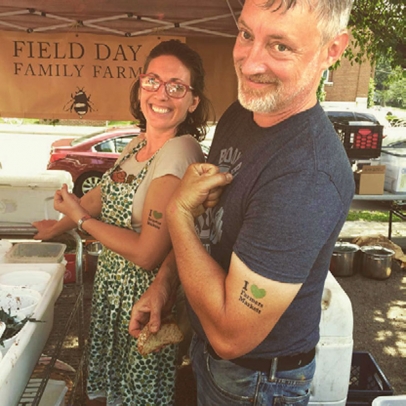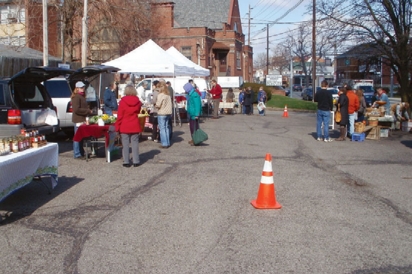The Early Path to Local
Restocking at the Bardstown Road Farmers’ Market was a full time job in the ’00s, including lacinato and red Russian kale; three colors of Swiss chard; orange and yellow carrots; three kinds of salad greens; gold, Chioggia and red beets; dill; cilantro; winter squashes; three varieties of potatoes and so many other things.
And then there was tomato stocking: hundreds and hundreds of pounds, each one polished and turned shoulders-down to prevent bruising. I remember the day when I just couldn’t stop to talk with Larry Snyder. A quick joke about my less-than-stylish boots–and-shorts combination had to suffice.
With the proliferation of farmers’ markets and commodity-type food delivery services, it is a little less busy these days than back then, but the quality and diversity of products available at the Bardstown
Road Farmers’ Market and other markets is unsurpassed. Because of the ongoing hospitality of the Bardstown Road Presbyterian Church, the market was able to lengthen the season early on and, really, to pioneer as Louisville’s first and still only year-round farmers’ market.
It was decidedly because of the availability of local pastured beef, pork, chicken, lamb and eggs, along with a variety of value-added products, that vegetable growers like me felt comfortable investing in winter production, not to mention knowing that, at some point during a snowy Saturday in February, my toes would go numb.
More than this, though, the market helped create the expectation of year-round productivity, with regular folks along with chefs like Bruce Ucan of the Mayan Café and Jacob Coronado from Red Herring knowing that, for the creative, there are real year-round opportunities. Be sure, though, it hasn’t always been this way. Back in the 1990s, in the days of Ed Fackler from Rocky Meadow Orchard and Leo Keene and Jean Pitches from Blue Moon Farm, farmers’ markets were actually a hard sell. Back then it wasn’t unusual to leave the market with somewhere in the neighborhood of a hundred bucks. I sold bunches of beets for $1.25, salad greens for just four bucks a pound.
Jane Conrad, just a few years before, sat on the tailgate of her truck for four hours and took home most everything she had hoped to sell.
Thankfully, today our agricultural situation is formidable in a different way. Run by farmers, the market is well positioned both to see the challenges farmers most often face and to come up with solutions that offer a balance of vision and practicality. There is still real big-picture work to be done in the local food movement and I now have time to participate in helping to create other more broad-based opportunities around local food. I feel I’ve taken Harvest Restaurant as far as I am able with having helped to elevate the conversation around farm-to-table cuisine. I am grateful that local food is, well, still really sexy and I am grateful to Kathy Jackson for her having asked me to serve as Board President of the market.
I may make fewer omelets, but if, in some small part, I can help make the case both that food distinctions are more important than ever and that modest amounts of time spent preparing foods from local farms, as a practice, not only supports consumers but their community and their environment as well, then I will feel like I’ve really accomplished something worthwhile! Help me and make it a part of your practice to buy local today!







